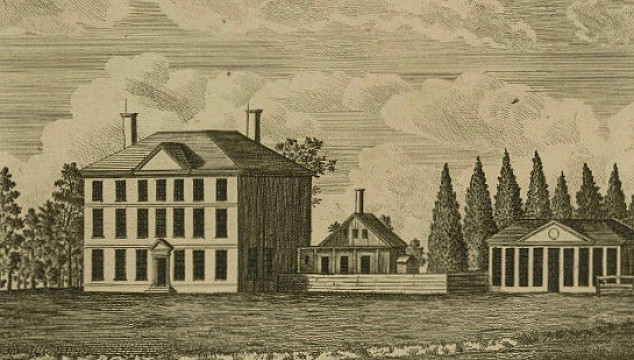Bush Hill
Philadelphia, Pennsylvania

This house is best associated with...
A "Noble" Home to Pennsylvania's First Notable Art Collection
In 1737, Hamilton's "noble" south-facing, three-story brick mansion measured 54 feet across and was built on the highest rise of the estate, complete with numerous outbuildings that included stables, a coach house, ice house and a separate kitchen wing. A portrait of the family's benefactor, Mrs Hannah Penn, hung in the hall, but Hamilton died just four years later and was buried here on the estate that he named "Bush Hill". Among other property - that amounted to some 10,000-acres - he left his home to his eldest son, James Hamilton, the only native born Governor of Colonial Pennsylvania.
Robbers and Revolution
Hamilton eventually went with the British to New York, where he died in 1783 and the estate passed to his nephew, William Hamilton, who soon afterwards embarked for a two year trip to Europe. When William returned to Philadelphia, he briefly made his home here before his sumptuous new residence, The Woodlands was habitable from 1789. It was during that time (1787) that he and his niece were set upon one night and shot at in their carriage by six robbers who were chased on horseback into a cornfield by his servants.
Union Green & the Vice-Presidential Residence
The following year, Hamilton allowed its front lawns to be used as the parade terminus for the Federal Procession of July 4th, 1788, where celebrations were held to mark the establishment of the new U.S. Constitution. The front lawn on which crowds of over two thousand people had gathered that day was given the name "Union Green". Perhaps fittingly, when the Federal government came to Philadelphia in 1790, Hamilton rented Bush Hill to Washington's Vice-President (Presidential successor), John Adams.
I am told that this spot is very delightful as a summer residence. The house is spacious. The views from it are rather beautiful than sublime; the country round has too much of the level to be in my style; the appearance of uniformity wearies the eye, and confines the imagination. We have a fine view of the whole city from our windows; a beautiful grove behind the house, through which there is a spacious gravel walk, guarded by a number of marble statues, whose genealogy I have not yet studied, as the last week is the first time I have visited them.
"A Dread Charnel House of Fear, Dismal Suffering and Death"
Tavern, Factory and Flattened
The house continued to sink into decline becoming a tavern and resort until the Hamilton heirs sold it in 1818 to Isaac Macauley - the first manufacturer of oil-cloths in the United States. He remodelled it from a tavern into an oil cloth manufacturing factory and added several new buildings including a new "fine mansion" on Hamilton Street for himself. By 1835, much of the former estate had been sold off, the largest tract having been purchased by Oliver Parry (1794-1874) and his nephew Nathaniel Randolph (1817-1858). The area became increasingly industrialized and a brick factory and the Bush Hill Ironworks were erected on the former gardens. Macauley eventually sold the property to Thomas Potter who maintained it as an oil-cloth factory until he was forced to move in 1871 in consequence of the street-widening project on Spring Garden Street. The former mansion was finally demolished in 1875 to make way for new re-development and new residences.
You May Also Like...
Categories
Styles
Share
Connections
There are 2 members connected to this house, are you? Connect to record your link to this house. or just to show you love it! Connect to Bush Hill →
Patricia loves Bush Hill
Richard C Mousseau's ancestor, Andrew Hamilton, owned Bush Hill












